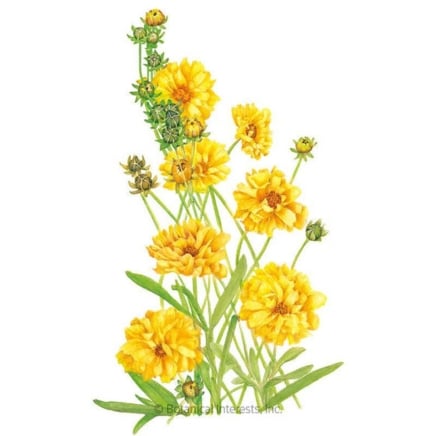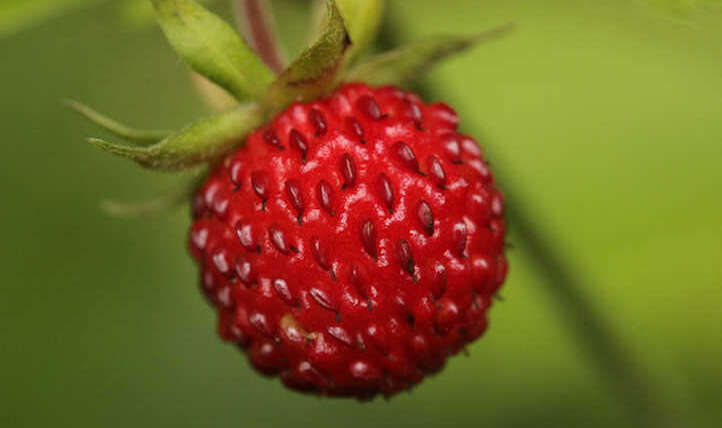For cool-climate gardeners, entering fall means that their window for planting is drawing to a close. But for warm-climate gardeners, fall means the end of intense heat and summer stress, welcoming an abundance of vegetable and flower seeding options.
Here in the warm climate of zone 9, early fall is the perfect time to plant many perennial flowers and some frost-tolerant annuals. We experience some frost here, so tender annuals must be fast bloomers. Some of the seeds I sow in the fall won’t flower until spring.
In autumn, the soil is warm, and the rain is plentiful. The warm soil encourages fast root growth, and the cool air keeps stress to a minimum for the top growth. Stronger roots mean that the plant will grow more vigorously and earlier when it comes out of dormancy.
A note on fertilizer in autumn: I only recommend using nitrogen when planting my seeds or starts. This gives them an initial burst of green growth while it’s warm enough to get things growing. After that, I switch to a phosphate and potassium-heavy formula. This produces strong flowers in frost-proof flowers or strong roots in spring bloomers.
Let me tell you about some of my favorite annual bloomers and some perennial flowers to plant this autumn.
Double Sunburst Coreopsis
Double Sunburst Coreopsis Seeds
Orange Wonder Snapdragon

Orange Wonder Snapdragon Seeds
Beaujolais Sweet Pea

Beaujolais Sweet Pea Seeds
Sweet Pea ‘Beaujolias’
 Their attractive foliage is frost-tolerant, so you’ll have pretty vines all winter.
Their attractive foliage is frost-tolerant, so you’ll have pretty vines all winter.
Sweet peas have excellent cold tolerance, and they are fast growers. They need about 50 days of temperatures in the 50s and 60s to produce flowers (~10-16°C). With the first anticipated frost date of December 15th in my zone, I can plant as soon as the weather cools a bit. I may get flowers before that first frost, or it may happen in very early spring. It all depends on what the weather does.
Either way, sweet pea flowers are best planted in the fall in warm climates. If you wait until spring, you won’t have a long blooming season. They stop blooming when it gets warm again. Their attractive foliage is frost-tolerant, so you’ll have pretty vines all winter.
Sweet peas are nitrogen-fixing, so they help to rejuvenate the soil you plant them in. They like soil that drains well but stays moist. Full sun beds will get you the most flowers. I’m planting beautiful ‘Beaujolais’ in addition to a spice mix for extra fragrance.
Snapdragon ‘Orange Wonder’
 They flower exceptionally in full sun and rich, well-drained soil.
They flower exceptionally in full sun and rich, well-drained soil.
Snapdragons are another charming frost-resistant flower that benefits from fall planting in warmer climates. Though they are often grown as annuals, snapdragons are perennial in zones 5-11. Here in zones 9 and south, they look their best in winter and early spring.
Snapdragons are among the earliest and best bloomers in my North Florida garden. They flower exceptionally in full sun, and rich, well-drained soil supports their roots.
I’m planting ‘Orange Wonder’ this year because it is my favorite shade for this flower. I’m also planting ‘Madame Butterfly,’ an ivory, double-petaled variety, for my sister’s wedding in the spring. There are so many beautiful shades to choose from, and picking just one is hard.
Coreopsis ‘Double Sunburst’
 It will be one of the earliest and most prolific bloomers, and it’s a perennial!
It will be one of the earliest and most prolific bloomers, and it’s a perennial!
If you want to attract overwintering pollinators, plant some coreopsis in your yard. Though it may not bloom until next spring, the foliage is frost-proof and will remain green in Zone 9. In 4-8, the foliage may die back after a hard freeze but return robustly in early spring.
Coreopsis grows well in containers and fills in quickly as soon as spring rolls around. It will be one of the earliest and most prolific bloomers, and it’s a perennial! They can tolerate poor soil, so they are good for coastal areas. I’m excited to see some ‘Double Sunburst’ plants popping up this year. The double-petaled form makes these feel extra special.
Pansy ‘Got the Blues’
 Their smooth, rounded petals and range of beautiful colors make them a joy to grow.
Their smooth, rounded petals and range of beautiful colors make them a joy to grow.
Pansies are such happy little things. Their smooth, rounded petals and range of beautiful colors make them a joy to grow. These small plants are very cold-tolerant. They will continue to grow after a frost and even tolerate periods of temperatures as low as 10°F (-12°C).
I grow these in containers because they are small and delicate, and I like to use the flowers to decorate baked goods. The flowers are edible and have a pleasantly mild and sweet flavor. I can’t wait for my ‘Got the Blues’ pansies to get growing! They prefer partial shade, but full sun is fine in cooler weather with consistent moisture.

Bachelor’s Button ‘The Bride’
 They are also frost tolerant, so they will continue to look nice until a hard freeze.
They are also frost tolerant, so they will continue to look nice until a hard freeze.
Bachelor’s buttons are nostalgic flowers that were popular in the Victorian Era. Men wore them in a buttonhole to indicate they were not yet married. They bloom quickly, so if you plant them 12-14 weeks before the first freeze date, they should bloom before winter comes. They are also frost tolerant, so they will continue to look nice until a hard freeze.
I’m planting ‘The Bride’ this year in the hope that these, too, will bloom in time for my sister’s wedding. That theme is running through my autumn planting this year. Of course, the blue varieties are classic and oh-so beautiful. Maybe I’ll plant both!
Calendula ‘Oopsy Daisy’
 They have vibrant resinous blooms.
They have vibrant resinous blooms.
Calendula makes a good neighbor for sweet peas. Sweet peas grow upward on a support, leaving a very small footprint. The base of the trellis is a perfect spot for some bright and cheerful calendula. This is a fast bloomer, with flowers opening up in only six to eight weeks after germinating.
Once you grow a variety of calendula that you love, it’s a piece of cake to collect the seeds to plant next year. I love the bright orange of ‘Oopsy Daisy.’ The blooms are mid-sized and sturdy. The more you cut them, the more they produce. They can handle a light frost, but a hard freeze will be the end of them.
Stock ‘Anytime Deep Purple’
 Stock is fragrant and makes an excellent cut flower because of its long vase life.
Stock is fragrant and makes an excellent cut flower because of its long vase life.
This is a new flower for me this year. I’ve not grown it before, but I’m excited to start. Stock is a perennial in cooler climates, but here, it won’t survive the heat and humidity of summer. I’m planting in the fall for early spring flowers and an extended bloom time in my warm-summer climate. They take 90-140 days to bloom.
I decided on ‘Deep Purple’ this year because of the bold and vivid shade of the flowers. Stock is fragrant and makes an excellent cut flower because of its long vase life. They like moisture and rich soil with plenty of organic material.
Ranunculus ‘Tecolote Pink’
 Once established, they will pop up in the autumn and flower in late winter to early spring.
Once established, they will pop up in the autumn and flower in late winter to early spring.
Ranunculus is a great spring bloomer, but it needs an extended cool season to reach its blooming period. Here in zone 9, that means we have to plant them in the autumn or early winter, or they will burn up before they get a chance. They are warm-climate plants, though, so if you live in zones 8-11, you can leave the corms in the ground all year.
In cooler climates, these are spring-planted because they are not especially cold-tolerant. Once established, they will pop up in the autumn and flower in late winter to early spring. They are frost-tolerant. I have several varieties going in this year, but ‘Telocote Pink’ is the one I’m most excited about.
Japanese Anemone ‘Fall Charm’
 The blooms are stunning, and they make excellent cut flowers.
The blooms are stunning, and they make excellent cut flowers.
I’ll be planting Japanese anemones this year, though I won’t expect flowers for a while. These late summer and autumn bloomers take about two years to get established. The blooms are stunning, and they make excellent cut flowers. They’re also low-maintenance once they put down roots.
My climate is a bit hot for Japanese Anemones. I will need to plant them in partial shade and keep the soil moist in summer. In zone 8, they will thrive. Unfortunately, for those farther south, these are probably out of the question. I’m excited about the beautiful ‘Fall Charm’ variety. It has two-toned purple blossoms for six to eight weeks in the early fall.
Globe Thistle ‘Veitch’s Blue’
 These won’t look like much this year, but next season, they will be gorgeous.
These won’t look like much this year, but next season, they will be gorgeous.
I’m planting globe thistle in the autumn this year, but I won’t be seeing those spiky blooms until next year. So why am I planting in the fall? Globe thistle seeds need a period of cold to do their best germinating. They also need light.
Sow these seeds on the soil’s surface and water once deeply. Then stop watering and resume in spring. These won’t look like much this year, but next season, they will be gorgeous. I chose ‘Ritro Blue’ as the variety I will plant this year, but the white varieties are also very tempting.
Crimson Clover
 Bees love the bright red flowers, which are prolific, so they brighten up the cold months.
Bees love the bright red flowers, which are prolific, so they brighten up the cold months.
Many don’t consider this final flower because it’s typically used as a cover crop. I’m talking about crimson clover, and cover cropping is exactly why this is on my list. I’m a beekeeper, so I’ll make space for anything that flowers in winter. Bees love the bright red flowers, which are prolific, so they brighten up the cold months.
Sow these seeds in your depleted annual beds to put nitrogen back into the soil. Clover is a nitrogen fixer, like sweet peas. Enjoy the flowers, and then before they go to seed, mow them or cut them at the ground level and use them as green mulch. The annuals you plant in spring will appreciate the nitrogen boost they get.
This plant is an invasive species in certain areas of North America. Do what you can to avoid planting in these areas, and contain the spread of crimson clover as much as possible.




